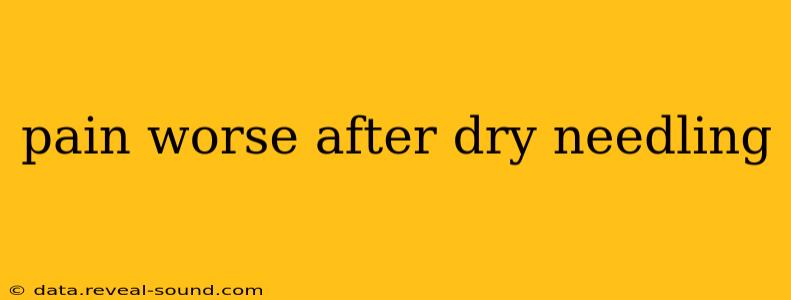Dry needling, a technique used by physical therapists and other healthcare professionals, involves inserting thin needles into muscles to relieve pain and improve function. While it's often effective, some individuals experience increased pain afterward. This isn't necessarily a cause for alarm, but it's crucial to understand why it happens and what steps to take. This article will explore the reasons behind post-dry needling pain and offer guidance on managing it.
Why Does My Pain Feel Worse After Dry Needling?
This is a common concern, and thankfully, there are several explanations, most of which are temporary:
-
Muscle Soreness: Similar to the soreness experienced after a strenuous workout, dry needling can cause muscle soreness. This is a normal response to the stimulation of the muscle fibers. The needles create micro-tears, triggering the body's natural healing process, which can manifest as temporary discomfort. This usually peaks within 24-48 hours and gradually subsides.
-
Inflammation: The process of dry needling can trigger a localized inflammatory response. This is the body's way of repairing the micro-trauma caused by the needles. While inflammation is a normal part of the healing process, it can lead to increased pain and tenderness. This typically resolves within a few days.
-
Referral Pain: Dry needling aims to treat trigger points, areas of muscle tightness that can refer pain to other parts of the body. Sometimes, temporarily, pain might feel worse in the referral area before improving. This is often a sign that the treatment is working, as it indicates that the trigger point is being addressed.
-
Trigger Point Activation: The process of stimulating a trigger point with a needle can sometimes cause a temporary increase in pain before it decreases. This is because the needle is activating the point, causing it to release tension.
How Long Does Increased Pain After Dry Needling Last?
The duration of increased pain varies greatly depending on individual factors, such as the severity of the condition, the number of needles used, and the patient's overall health. In most cases, any increase in pain should subside within 2-3 days. If the pain persists beyond this timeframe or worsens significantly, it's crucial to contact your healthcare provider.
What Should I Do if My Pain Is Worse After Dry Needling?
-
Rest: Avoid strenuous activities that could aggravate the affected muscles. Rest allows your body to focus on healing.
-
Ice: Applying ice packs to the treated area for 15-20 minutes at a time, several times a day, can help reduce inflammation and pain.
-
Over-the-Counter Pain Relief: Nonsteroidal anti-inflammatory drugs (NSAIDs) like ibuprofen or naproxen can help manage pain and inflammation. Always follow the dosage instructions on the label.
-
Gentle Movement: While rest is important, gentle movement can also aid recovery. Light stretching or range-of-motion exercises can help prevent stiffness and promote healing. Discuss appropriate exercises with your therapist.
-
Contact Your Healthcare Provider: If your pain worsens significantly, persists for more than a few days, or is accompanied by other symptoms like fever or redness, contact your healthcare professional immediately. This is crucial to rule out any complications.
Is It Normal to Have Increased Pain After Dry Needling?
While many experience some temporary increase in discomfort, severe or prolonged pain is not a typical outcome. It's always best to discuss your concerns with the practitioner who performed the dry needling. They can assess your individual situation, provide reassurance, and adjust the treatment plan as needed.
Can Dry Needling Make My Pain Worse Long-Term?
Dry needling should not cause long-term worsening of pain. In fact, the goal is to reduce pain and improve function. If you experience persistent pain, it's important to discuss this with your healthcare provider to determine the cause and explore alternative treatment options.
By understanding the potential reasons for increased pain after dry needling and following the appropriate steps, you can increase the likelihood of a successful and comfortable treatment experience. Remember, communication with your healthcare provider is key to achieving the best possible outcome.
